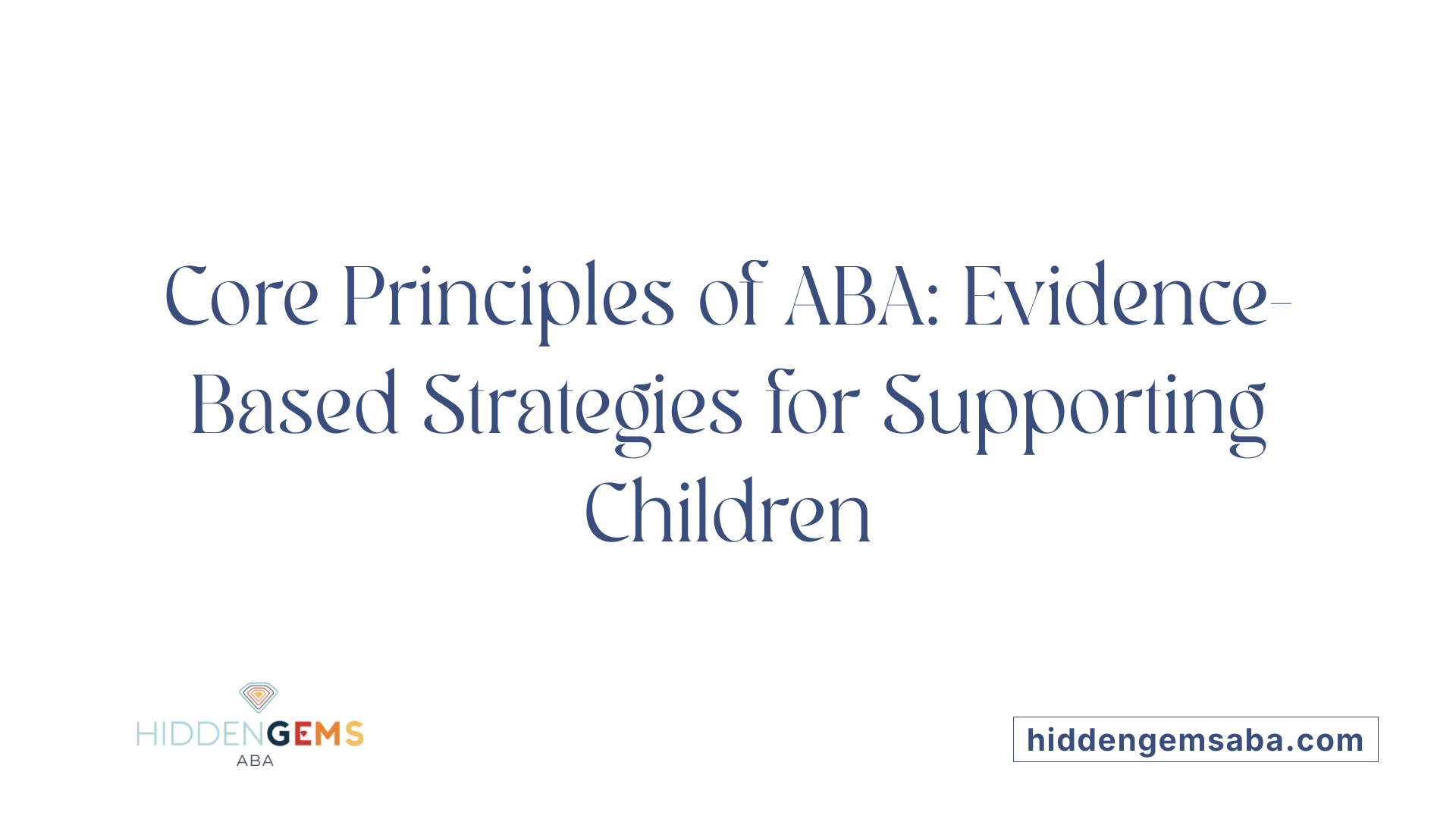Understanding ABA Therapy and Its Significance
Applied Behavior Analysis (ABA) therapy is an evidence-based intervention that uses the science of learning and behavior to support children with neurodevelopmental and mental health conditions. Its primary goal is to enhance adaptive skills while reducing problematic behaviors, thereby fostering independence and improving overall quality of life. Over the years, ABA has evolved from its early, intensive, punishment-based beginnings to a more nuanced, ethical, and child-centered approach, emphasizing positive reinforcement, naturalistic learning, and collaboration with families and other professionals.
A Brief History and Ethical Foundations of ABA Therapy

How did ABA therapy develop from the 1960s to today?
Applied Behavior Analysis (ABA) has its roots in the 1960s, when researchers began formalizing the scientific principles of learning and behavior. Early work by B.F. Skinner, a prominent psychologist, laid the groundwork for reinforcement theories that became central to ABA. During this time, the focus was primarily on modifying behaviors through structured interventions.
In the 1980s, Ole Ivar Lovaas pioneered intensive ABA programs for children with autism, claiming significant improvements, sometimes describing outcomes as 'recovery.' However, these early approaches often relied heavily on punishment and compliance strategies.
Over the decades, the methodology shifted towards positive reinforcement and naturalistic teaching, emphasizing child engagement and individualized goals. Today, ABA is recognized globally as an evidence-based standard for supporting children with autism and other developmental disorders.
Who were the influential figures in ABA’s development?
- B.F. Skinner: His reinforcement theories provided the foundational science for behavior modification.
- Ole Ivar Lovaas: Known for pioneering intensive ABA programs and advocating for early intervention in autism.
Their work propelled ABA from theoretical underpinnings to practical applications that have influenced contemporary practices.
Transition from punishment-based to positive reinforcement methods
Originally, ABA involved techniques like punishment and compliance to shape behavior. Over time, clinicians and researchers realized that such methods could be harmful or produce negative emotional responses.
Modern ABA emphasizes positive reinforcement—rewarding desirable behaviors—to promote learning. This approach is more engaging, respects the child's dignity, and aligns with ethical standards.
Behavior support strategies now often incorporate naturalistic teaching, focusing on skill-building within play and daily routines.
What are current standards emphasizing ethics and respect?
Contemporary ABA practices prioritize ethics, personalization, and respecting autistic identities. This entails:
- Ensuring interventions are child-centered and culturally sensitive
- Involving families as active partners
- Avoiding punitive techniques
- Providing treatment tailored to individual preferences and strengths
Professional organizations and guidelines stress ongoing assessment and ethical training for practitioners. These standards aim to promote positive outcomes while safeguarding the child's well-being and dignity.
| Aspect | Historical Practice | Modern Practice | Additional Notes |
|---|---|---|---|
| Approach | Punishments, compliance enforced | Positive reinforcement, naturalistic strategies | Focus on engagement and respect |
| Practitioner Focus | Behavior conformity | Support, empowerment, personalized goals | Emphasizes child's autonomy |
| Ethical Emphasis | Potential harm, compliance-based | Dignity, safety, cultural sensitivity | Continuous evaluation and adaptation |
| Treatment Duration | Intensive, long hours, early start | Flexible, tailored, ongoing assessments | Patient-centered, family involvement |
Through decades of evolution, ABA continues to adapt, aiming for effective, ethical support that honors each child's unique identity and needs.
Understanding the Core Principles of ABA and Its Approach

What is ABA therapy, and what are its approaches, history, and ethical considerations when supporting children with complex diagnoses?
ABA, or Applied Behavioral Analysis, is a scientifically supported method used to improve social, communication, and learning skills in children, especially those with autism spectrum disorder (ASD). Its foundation is analyzing how a child's environment influences their behavior, and then applying strategies such as positive reinforcement, prompting, and extinction to promote desired behaviors.
Historically, ABA emerged in the 1990s, based on reinforcement principles initially used to modify children's behaviors. Early research claimed it could make autistic children indistinguishable from their peers, but some of these claims were later questioned for reliability. Despite this, ABA developed into a structured, intensive therapy often provided 40 hours a week, with aims to improve self-care, communication, and social skills.
However, the ethical landscape surrounding ABA has evolved. Critics argue that older practices involved harmful methods like punishment and forced compliance, which could be traumatic. Nowadays, contemporary ABA emphasizes understanding behavior as communication, incorporating more child-led, engaging, and respectful approaches to reduce trauma and support autonomy.
How does ABA therapy base its interventions on environmental relationships?
A core aspect of ABA is understanding how environmental factors—antecedents (what happens before a behavior) and consequences (what follows)—affect behavior. Therapists analyze these relationships to identify triggers and reinforce alternatives that promote positive change.
This approach allows for targeted interventions that modify the child's environment, making it more supportive of desired behaviors. By systematically studying behaviors and their contexts, ABA practitioners can develop personalized strategies that are both effective and respectful of each child's unique needs.
What techniques are used within ABA therapy?
ABA employs various techniques like reinforcement, prompting, and extinction:
- Positive Reinforcement: Providing rewarding stimuli after desirable behaviors to encourage their recurrence.
- Prompting: Offering cues or assistance to help the child perform a new skill.
- Extinction: Reducing undesired behaviors by withholding reinforcement.
Many strategies are delivered through naturalistic and play-based methods, making learning enjoyable and engaging for children. Data collection throughout therapy ensures that treatment plans are tailored and adjusted based on the child's progress.
How are treatment plans individualized and data-driven?
Each child's therapy plan is custom-made, reflecting their strengths, challenges, and preferences. Frequent assessments and data collection help therapists monitor progress and modify interventions as necessary.
This personalized and flexible approach ensures therapy remains relevant and effective while respecting the child's pace and comfort. Family involvement is also encouraged, supporting skill generalization across different settings.
What role does naturalistic and enjoyable learning play?
Modern ABA emphasizes naturalistic, play-based learning experiences that children find fun. These methods involve integrating teaching into everyday activities and play, reducing stress and increasing motivation.
By making therapy enjoyable, children are more likely to participate actively, leading to better skill acquisition and emotional well-being. This approach aligns with ethical standards that prioritize the child's best interests and autonomy.
The Multidisciplinary Roots and Implementation of ABA

How does ABA therapy involve a team-based approach with families, therapists, and educators?
ABA therapy is delivered through a collaborative effort that includes families, therapists, and educators working together to support the child's development. This team-based approach ensures consistency across settings and reinforces learning and behavioral goals in various environments.
Family involvement is crucial, as it helps generalize skills acquired during therapy to daily life, strengthening the overall effectiveness of interventions. Therapists and educators coordinate regularly, sharing insights and adjusting strategies to meet the child's evolving needs.
How is ABA integrated with other therapies like speech and occupational therapy?
ABA often works alongside speech, occupational, and other specialized therapies. Combining these approaches provides a comprehensive support system—targeting communication, motor skills, sensory processing, and social interaction—more effectively than any single therapy alone.
Integrated therapy plans are tailored to the child's unique profile, ensuring that progress in one area complements advancements in others, ultimately promoting well-rounded development.
What is the role of Behavior Technicians (RBTs), and how are they trained?
Behavior Technicians, or Registered Behavior Technicians (RBTs), are the frontline implementers of ABA therapy. They work directly with children, applying intervention strategies under the supervision of qualified professionals.
To become an RBT, individuals must undergo formal training, which typically includes coursework and supervised practical experience. Certification can be obtained within 90 days of employment, ensuring that RBTs are well-prepared to support treatment plans effectively.
How are treatment durations and goals designed to be flexible and adaptive?
The length and intensity of ABA therapy are tailored based on the child's specific needs, with recommended hours ranging from 10 to 40 per week. These plans are flexible, evolving over time as the child's skills improve or as new challenges arise.
Regular assessments monitor progress, guiding modifications to goals and strategies. This responsiveness ensures that therapy remains effective, engaging, and respectful of each child's individual development trajectory.
ABA's Role in Supporting Children with Anxiety and Autism
How does ABA therapy support children with conditions such as anxiety and autism?
Applied Behavior Analysis (ABA) therapy is a proven, evidence-based approach that helps children with autism spectrum disorder (ASD) and anxiety develop essential skills and reduce challenging behaviors. It involves creating individualized programs that focus on communication, social interactions, and emotional regulation.
A core aspect of ABA is analyzing the relationship between the child's environment and their behaviors. Therapists identify triggers—specific situations or stimuli that may induce anxiety or problematic behaviors—and work to modify these antecedents, making challenging situations more manageable.
ABA incorporates techniques like positive reinforcement, which rewards desired behaviors, encouraging children to repeat them. It also adjusts the environment to support learning, often breaking down complex tasks into smaller, achievable steps.
Techniques like desensitization, social skills training
One effective technique used in ABA for anxiety reduction is desensitization. This involves gradually exposing the child to anxiety-provoking stimuli in a controlled manner, helping them build tolerance and confidence.
Social skills training is another vital component, teaching children how to interact appropriately with peers and adults. These sessions often use role-playing, social stories, and modeling to promote understanding and comfort in social settings.
Addressing triggers and promoting coping strategies
ABA therapy focuses heavily on recognizing specific triggers for anxiety and teaching children coping strategies. These might include relaxation techniques, cognitive restructuring (changing negative thought patterns), or self-calming methods.
By systematically teaching these skills, children learn to manage their emotional responses better, leading to less frequent or intense anxiety episodes.
Evidence supporting anxiety reduction
Research indicates that ABA can significantly decrease social anxiety and reduce anxiety in school environments. Studies show improvements in children’s ability to handle stressful situations, participate more fully in classroom activities, and engage in community outings.
In practice, regular monitoring and data collection ensure that interventions remain effective and are adjusted as needed. Parental involvement further enhances outcomes by helping to generalize skills across different settings.
Individualized programs addressing emotional and social development
Every child’s needs are unique, and ABA programs are tailored accordingly. Treatment plans integrate goals related to emotional well-being and social development, ensuring a comprehensive approach.
Parents, educators, and therapists collaborate to set realistic objectives and adapt strategies over time. This customized approach not only promotes skill acquisition but also respects the child's individuality and promotes their overall quality of life.
Summary Table:
| Aspect | Techniques/Strategies | Focus Areas |
|---|---|---|
| Anxiety support | Desensitization, relaxation, cognitive restructuring | Reducing triggers, promoting coping skills |
| Social development | Role-playing, social stories, modeling | Improving peer interactions and social understanding |
| Program customization | Data-driven adjustments, family involvement | Ensuring relevance and effectiveness |
ABA therapy continues to evolve with an emphasis on naturalistic and child-led approaches, fostering a supportive environment for children with autism and anxiety to thrive.
Managing Comorbid Neurodevelopmental and Mental Health Conditions with ABA
What is the role of ABA therapy as an intervention for children with neurodevelopmental and mental health disorders?
ABA therapy is a science-based approach that focuses on understanding how environmental relationships influence a child's behavior. It uses positive reinforcement and careful adjustments to triggers and consequences to promote valuable skills and reduce harmful behaviors.
This therapy is especially effective for children with autism, providing a highly individualized treatment plan that aims to improve areas like communication, social skills, self-care, and academic abilities. Trained professionals, called behavior analysts, design these plans based on thorough assessment, ensuring activities are engaging and suited to each child's needs.
Modern ABA techniques incorporate playful, naturalistic learning opportunities, making the process enjoyable while fostering meaningful progress. For instance, therapy sessions may involve interactions that encourage language development, social referencing, and emotional understanding, all within a fun and supportive environment.
The evidence backing ABA's effectiveness shows significant improvements across multiple domains. Children often experience enhanced cognitive functioning, better community participation, and greater independence. Additionally, ABA can help diminish problematic behaviors, including anxiety and aggression, by teaching functional alternatives that meet the child's communication and emotional needs.
It is recognized as a gold standard treatment by leading health authorities due to its rigorous, data-driven approach and proven results. This method can be adapted to accommodate other conditions like ADHD, OCD, and seizure disorders, often in coordination with medication or other therapies.
Different service models allow for varying intensities, from 10 to 40 hours per week, depending on individual requirements and goals. Early initiation and consistent engagement in ABA are crucial for long-term success, especially when started soon after diagnosis.
Families play a vital role in therapy, participating in strategies alongside professionals to help generalize skills across different settings such as home and school. Ongoing evaluations ensure the therapy remains suitable and effective, adjusting the focus as the child progresses.
In summary, ABA serves as a comprehensive, adaptable tool for supporting children with complex neurodevelopmental and mental health conditions. Its focus on positive, functional behaviors promotes overall well-being and helps children achieve greater independence and quality of life.
Enhancing Quality of Life and Supporting Families Through ABA
Fostering independence, emotional well-being, and social participation are central goals of ABA therapy. By systematically teaching children new skills and reducing barriers to social engagement, ABA helps children become more self-sufficient and emotionally resilient. The therapy emphasizes positive reinforcement and tailored strategies to support each child's unique needs, facilitating improvements across diverse areas of daily life.
Holistic, individualized care plans are fundamental to effective ABA practice. Therapists conduct comprehensive assessments to understand a child's strengths and challenges, designing programs that address specific developmental goals. These plans often integrate multiple domains such as communication, social skills, self-care, academic readiness, and safety, ensuring a balanced approach that promotes overall well-being.
Parental involvement plays a pivotal role in maximizing ABA's benefits. Families are encouraged to participate actively, learning strategies and reinforcing skills at home and in community settings. Advocacy is also essential, empowering parents to request modifications to therapy that better align with their child's preferences and needs. This collaborative approach fosters consistency, increases generalization of skills, and enhances the child's confidence and independence.
Long-term developmental progress is supported by early, consistent intervention tailored to the child's evolving needs. The duration of ABA therapy varies, often ranging from 10 to 40 hours weekly, and continues until targeted goals are achieved or meaningful progress stabilizes. Regular evaluations help guide adjustments, ensuring the therapy remains effective and respects the child's autonomy and interests.
Why is ABA therapy considered important in improving the quality of life for children with co-occurring conditions? ABA emphasizes teaching functional skills that support daily living, reduce anxiety, and improve social participation—fundamental aspects of a fulfilling life. Its individualized, evidence-based approach allows for personalized interventions that promote autonomy and emotional well-being. By addressing a broad spectrum of developmental domains, ABA contributes significantly to enhanced personal growth, community integration, and overall life satisfaction for children facing multiple challenges. These comprehensive strategies help children not only acquire specific skills but also foster resilience and happiness in diverse environments.
Addressing Concerns, Challenges, and Future Directions

What are the ethical considerations in ABA, especially regarding its use with children with severe autism?
Contemporary perspectives on ABA therapy emphasize a respectful, child-centered approach that upholds the dignity and autonomy of individuals with autism. Historically, ABA was introduced with the goal of making autistic children indistinguishable from their peers, sometimes involving intensive and, at times, controversial practices.
Today, many practitioners advocate for goals that focus on enhancing quality of life and supporting the child's own interests and needs. They emphasize collaboration with the individual and their family to develop respectful, engaging, and personalized interventions.
However, ongoing debates surrounding ABA often concern its ethical implications, particularly for children with severe autism. Critics highlight past abuses, such as the use of electric shocks or enforced compliance, which have left a legacy of trauma.
In response, there is a strong movement within the field toward more ethical practices. This includes reducing or eliminating aversive techniques and focusing more on fun, engagement, and naturalistic learning. Many professionals now strive to align interventions with the child's preferences, fostering a sense of safety and autonomy.
While ABA can offer significant benefits, it must be implemented within a framework that prioritizes the child's well-being, respects their individual identity, and continually assesses for potential harm. Overall, the evolution of ABA aims to balance the potential for positive outcomes with ethical responsibility, ensuring that practices are supportive, respectful, and non-coercive.
Moving Forward with Compassion and Respect
As ABA therapy continues to evolve, it remains a vital tool for supporting children with co-occurring conditions. By prioritizing ethical, individualized, and engaging interventions, practitioners and families can ensure that therapy not only promotes developmental gains but also upholds the dignity, autonomy, and well-being of each child. Embracing ongoing research, child-centered approaches, and multidisciplinary collaboration will pave the way for ABA to fulfill its promise as a truly supportive and empowering intervention.
References
- ABA Therapy
- Can ABA Therapy Help with Anxiety? In Many Cases, Yes
- Choosing the best therapy for neurodevelopmental disorders
- How a therapy once seen as a victory for autistic kids has ...
- Autism and Anxiety: Treatment Options and ABA Techniques
- Applied Behavior Analysis (ABA)
- treatment of anxiety in individuals with autism spectrum ...
- The Controversy Around ABA






